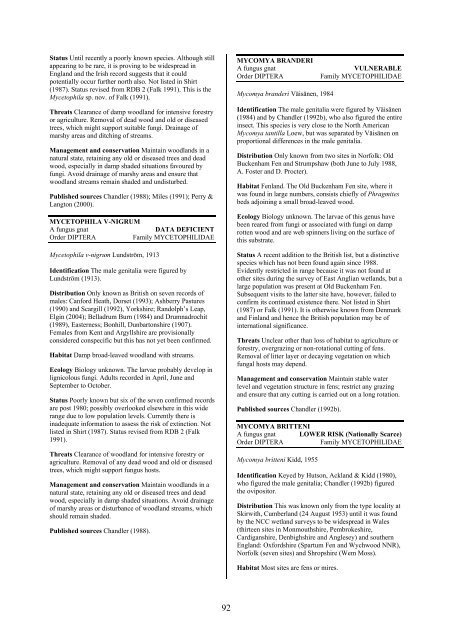Part 2: Nematocera and Aschiza not dealt with by Falk (1991) - JNCC
Part 2: Nematocera and Aschiza not dealt with by Falk (1991) - JNCC
Part 2: Nematocera and Aschiza not dealt with by Falk (1991) - JNCC
You also want an ePaper? Increase the reach of your titles
YUMPU automatically turns print PDFs into web optimized ePapers that Google loves.
Status Until recently a poorly known species. Although still<br />
appearing to be rare, it is proving to be widespread in<br />
Engl<strong>and</strong> <strong>and</strong> the Irish record suggests that it could<br />
potentially occur further north also. Not listed in Shirt<br />
(1987). Status revised from RDB 2 (<strong>Falk</strong> <strong>1991</strong>). This is the<br />
Mycetophila sp. nov. of <strong>Falk</strong> (<strong>1991</strong>).<br />
Threats Clearance of damp woodl<strong>and</strong> for intensive forestry<br />
or agriculture. Removal of dead wood <strong>and</strong> old or diseased<br />
trees, which might support suitable fungi. Drainage of<br />
marshy areas <strong>and</strong> ditching of streams.<br />
Management <strong>and</strong> conservation Maintain woodl<strong>and</strong>s in a<br />
natural state, retaining any old or diseased trees <strong>and</strong> dead<br />
wood, especially in damp shaded situations favoured <strong>by</strong><br />
fungi. Avoid drainage of marshy areas <strong>and</strong> ensure that<br />
woodl<strong>and</strong> streams remain shaded <strong>and</strong> undisturbed.<br />
Published sources Ch<strong>and</strong>ler (1988); Miles (<strong>1991</strong>); Perry &<br />
Langton (2000).<br />
MYCETOPHILA V-NIGRUM<br />
A fungus gnat<br />
DATA DEFICIENT<br />
Order DIPTERA<br />
Family MYCETOPHILIDAE<br />
Mycetophila v-nigrum Lundström, 1913<br />
Identification The male genitalia were figured <strong>by</strong><br />
Lundström (1913).<br />
Distribution Only known as British on seven records of<br />
males: Canford Heath, Dorset (1993); Ashberry Pastures<br />
(1990) <strong>and</strong> Scargill (1992), Yorkshire; R<strong>and</strong>olph’s Leap,<br />
Elgin (2004); Belladrum Burn (1984) <strong>and</strong> Drumnadrochit<br />
(1989), Easterness; Bonhill, Dunbartonshire (1907).<br />
Females from Kent <strong>and</strong> Argyllshire are provisionally<br />
considered conspecific but this has <strong>not</strong> yet been confirmed.<br />
Habitat Damp broad-leaved woodl<strong>and</strong> <strong>with</strong> streams.<br />
Ecology Biology unknown. The larvae probably develop in<br />
lignicolous fungi. Adults recorded in April, June <strong>and</strong><br />
September to October.<br />
Status Poorly known but six of the seven confirmed records<br />
are post 1980; possibly overlooked elsewhere in this wide<br />
range due to low population levels. Currently there is<br />
inadequate information to assess the risk of extinction. Not<br />
listed in Shirt (1987). Status revised from RDB 2 (<strong>Falk</strong><br />
<strong>1991</strong>).<br />
Threats Clearance of woodl<strong>and</strong> for intensive forestry or<br />
agriculture. Removal of any dead wood <strong>and</strong> old or diseased<br />
trees, which might support fungus hosts.<br />
Management <strong>and</strong> conservation Maintain woodl<strong>and</strong>s in a<br />
natural state, retaining any old or diseased trees <strong>and</strong> dead<br />
wood, especially in damp shaded situations. Avoid drainage<br />
of marshy areas or disturbance of woodl<strong>and</strong> streams, which<br />
should remain shaded.<br />
Published sources Ch<strong>and</strong>ler (1988).<br />
MYCOMYA BRANDERI<br />
A fungus gnat<br />
Order DIPTERA<br />
Mycomya br<strong>and</strong>eri Väisänen, 1984<br />
VULNERABLE<br />
Family MYCETOPHILIDAE<br />
Identification The male genitalia were figured <strong>by</strong> Väisänen<br />
(1984) <strong>and</strong> <strong>by</strong> Ch<strong>and</strong>ler (1992b), who also figured the entire<br />
insect. This species is very close to the North American<br />
Mycomya tantilla Loew, but was separated <strong>by</strong> Väisänen on<br />
proportional differences in the male genitalia.<br />
Distribution Only known from two sites in Norfolk: Old<br />
Buckenham Fen <strong>and</strong> Strumpshaw (both June to July 1988,<br />
A. Foster <strong>and</strong> D. Procter).<br />
Habitat Fenl<strong>and</strong>. The Old Buckenham Fen site, where it<br />
was found in large numbers, consists chiefly of Phragmites<br />
beds adjoining a small broad-leaved wood.<br />
Ecology Biology unknown. The larvae of this genus have<br />
been reared from fungi or associated <strong>with</strong> fungi on damp<br />
rotten wood <strong>and</strong> are web spinners living on the surface of<br />
this substrate.<br />
Status A recent addition to the British list, but a distinctive<br />
species which has <strong>not</strong> been found again since 1988.<br />
Evidently restricted in range because it was <strong>not</strong> found at<br />
other sites during the survey of East Anglian wetl<strong>and</strong>s, but a<br />
large population was present at Old Buckenham Fen.<br />
Subsequent visits to the latter site have, however, failed to<br />
confirm its continued existence there. Not listed in Shirt<br />
(1987) or <strong>Falk</strong> (<strong>1991</strong>). It is otherwise known from Denmark<br />
<strong>and</strong> Finl<strong>and</strong> <strong>and</strong> hence the British population may be of<br />
international significance.<br />
Threats Unclear other than loss of habitat to agriculture or<br />
forestry, overgrazing or non-rotational cutting of fens.<br />
Removal of litter layer or decaying vegetation on which<br />
fungal hosts may depend.<br />
Management <strong>and</strong> conservation Maintain stable water<br />
level <strong>and</strong> vegetation structure in fens; restrict any grazing<br />
<strong>and</strong> ensure that any cutting is carried out on a long rotation.<br />
Published sources Ch<strong>and</strong>ler (1992b).<br />
MYCOMYA BRITTENI<br />
A fungus gnat LOWER RISK (Nationally Scarce)<br />
Order DIPTERA<br />
Family MYCETOPHILIDAE<br />
Mycomya britteni Kidd, 1955<br />
Identification Keyed <strong>by</strong> Hutson, Ackl<strong>and</strong> & Kidd (1980),<br />
who figured the male genitalia; Ch<strong>and</strong>ler (1992b) figured<br />
the ovipositor.<br />
Distribution This was known only from the type locality at<br />
Skir<strong>with</strong>, Cumberl<strong>and</strong> (24 August 1953) until it was found<br />
<strong>by</strong> the NCC wetl<strong>and</strong> surveys to be widespread in Wales<br />
(thirteen sites in Monmouthshire, Pembrokeshire,<br />
Cardiganshire, Denbighshire <strong>and</strong> Anglesey) <strong>and</strong> southern<br />
Engl<strong>and</strong>: Oxfordshire (Spartum Fen <strong>and</strong> Wychwood NNR),<br />
Norfolk (seven sites) <strong>and</strong> Shropshire (Wem Moss).<br />
Habitat Most sites are fens or mires.<br />
92
















